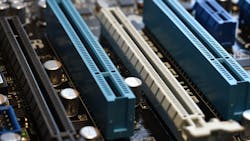What’s the Difference Going from PCIe 3.0 to PCIe 6.0? (.PDF Download)
The Peripheral Component Interconnect (PCI) architecture has provided I/O connectivity for computing, communication, and storage platforms for more than three decades. From its inception as a local bus interface for all types of I/O devices in the PC industry, it has evolved as a point-to-point link-based interface (PCI Express) to satisfy the I/O requirements across the cloud, enterprise, artificial intelligence, PC, embedded, IoT, automotive, and mobile market segments.
This is made possible due to the ability of PCI Express (PCIe) architecture to seamlessly deliver cost-effective, HVM (high-volume manufacturing) friendly, power-efficient, high-bandwidth, and low-latency solutions through six generations of technology evolution, doubling the data rate in every generation (Fig. 1) while maintaining full backwards compatibility with all prior generations to protect customer investments.
